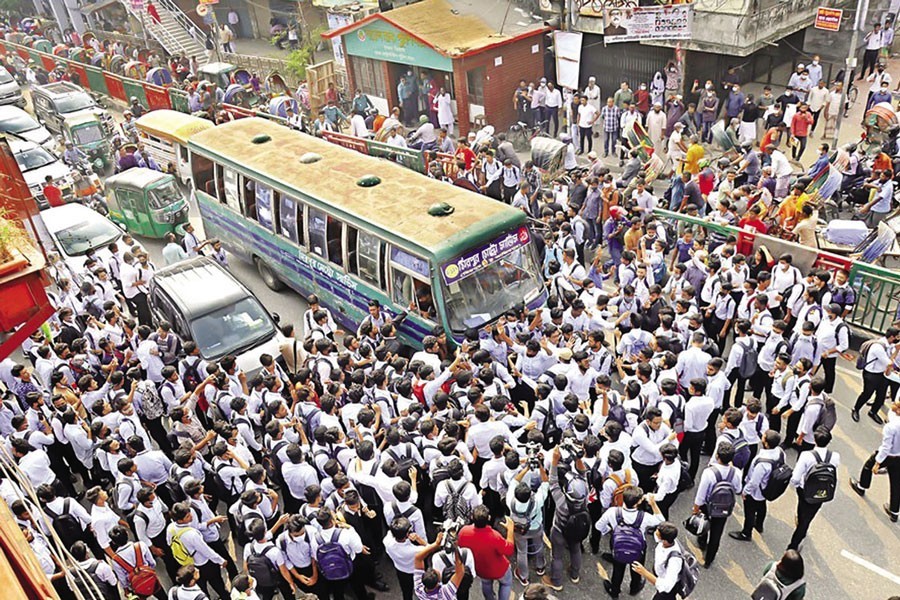The protest rallies on Rajshahi University campus following the tragic death of the RU student, motorcyclist Habib, on February 1 under the wheels of a track laden with stones for construction work continue to draw students and the general people alike. A pall of gloom coupled with suppressed anger has descended on the area. By today, February 8, a number of road accidents may have occurred. Some of them have been reported in the media, some remain passed over. However, a few caused grisly deaths on the road. Others prompted badly injured persons to land in hospitals.
In spite of sporadic street protests to press the demand for ensuring safe roads in different parts of the country, roads and highways still remain vulnerable to both fatal and minor accidents. In capital Dhaka, hardly a day passes which doesn't see collisions involving buses, covered vans, private cars, rickshaws, baby-taxis or pedestrians. Few can say in advance which vehicles will collide with which or, the most critical presumption of all, whether one can reach home unhurt. With Dhaka returning to a semblance of the quasi-normal after a nearly 2-month corona-prompted road movement restrictions, the city appears to be witnessing once again its earlier flurry of vehicles speeding past the others. It's especially seen in the cases of competing buses operated by incorrigibly reckless drivers.
But Dhaka's road scenario should have been different. Following the countrywide student protests against the devil-may-care style of driving of vehicles on July 29-August 8, 2018, with the agitations bordering on the verge of being drawn to a reign of anarchy, the movement drew to a close. Assurances came from the road transport authorities and people at the policymaking level that the traffic movements will henceforth be streamlined, i.e. will come under strict surveillance. As could be assumed, the roads in Dhaka and the other large cities offered a veritably metamorphosed look. With myriadtraffic police guiding various types of mechanised and non-mechanised vehicles, herding pedestrians into crossing busy roads through the designated places including overbridges, Dhaka wore a different look. Many residents heaved a sigh of relief on finding Dhaka free of traffic hazards. The comforting look didn't last long.
Befitting the invasive rot that ate away at the vitals of Dhaka's traffic system, the students came out into the streets in the very next year. This time the spectacle was different. The agitating students were not allowed to raise their voice in unison with the participation of the students from scores of institutions. In 2018, two college students were crushed to death under a speeding bus, an untrained driver at the wheel, at a Mirpur bus-stop. In 2019, a university student died upon being hit by another bus at Basundhara in the capital. Thanks to the prompt intervention by the DNCC mayor with promises of nabbing the culprits and proper punishment to them, theincensed students could be brought under control. Finally, they dropped their further agitations.
The irony is nobody can say with certainty if other such protest demonstrations will not flare up in another part of the capital; or the country for that matter. Many people have thought the combined pressure of the two student movements and the impact of corona restrictions will cut down on the recklessness resorted to by the drivers of large vehicles --- buses and trucks in the main. The Dhaka metropolitan traffic police authorities have long prohibited the plying of trucks in the city during the day. These heavy vehicles have taken scores of lives in Dhaka. It was after the brutal death of Sabiqunnahar, a BUET student, under the wheels of a truck at the intersection near Dhaka Medical College Hospital, that the government slapped a ban on the movement of trucks in Dhaka city. Highways aren't free of accidents. But few point it out while discussing road accidents in Bangladesh.
Moreover, apart from the city of Dhaka, many traffic filled roads in the other districts continue to watch terrible, but avoidable, deaths and injuries. On February 25 alone, a total of seven people died in Dhaka and four other districts. They include three motorcyclists. Twenty-three others were injured in the mishaps. The deadly accident in Dhaka saw a motorcyclist being hit by an oil tanker in the Rampura area. It sparked a spontaneous agitation demanding road safety. In Cumilla, another road accident claimed the lives of two motorcyclists on the Dhaka-Chattogram Highway. On the same day in the district's Debidwar area, a CNG-run auto-rickshaw driver met his death after a truck hit his vehicle. In the other road mishaps, a pickup driver and his assistant and a rickshaw-puller were killed in Dinajpur's Phulbari and Pabna Sadarupazila respectively.These accidents demonstrate the extent to which deaths and injuries have begun haunting the national and inter-district highways and local roads lately.
With the incidents of death and injury on an alarming rise across the country, it appears to remain bogged down like it did before the countrywide students' movements for safe roads. According to a police report published in the print media, 5,088 people were killed in 5,472 road accidents in 2021. The rate was 30pc higher than that of the previous year. The data have showed motorbikes were involved in 1,358 accidents last year, which is 41.46 per cent higher than in 2020.
An in-depth scrutiny of the anarchy related to traffic movement on the roads points the finger mostly at the errant vehicles.The flouting of traffic rules, their poor application, law breakers going scot-free etc add to the overall bedlam dominated by deaths. All this should be addressed holistically.


